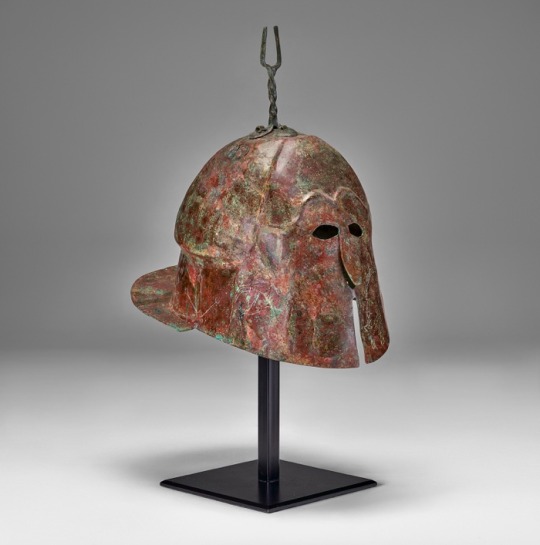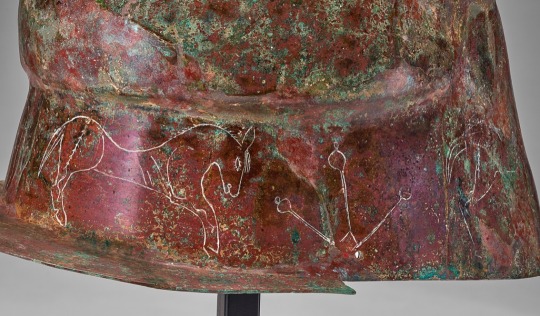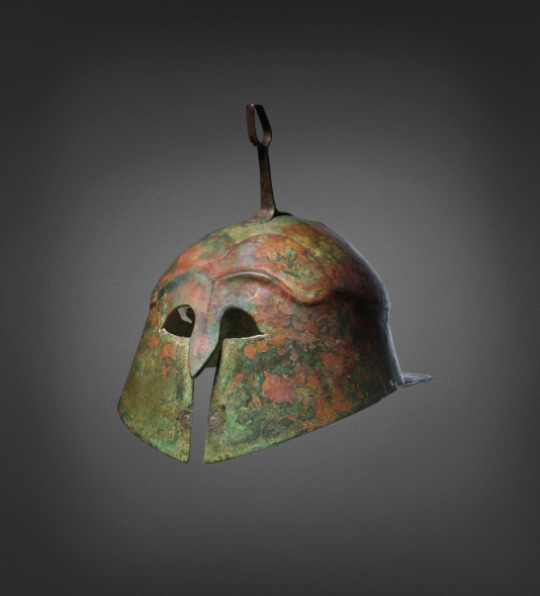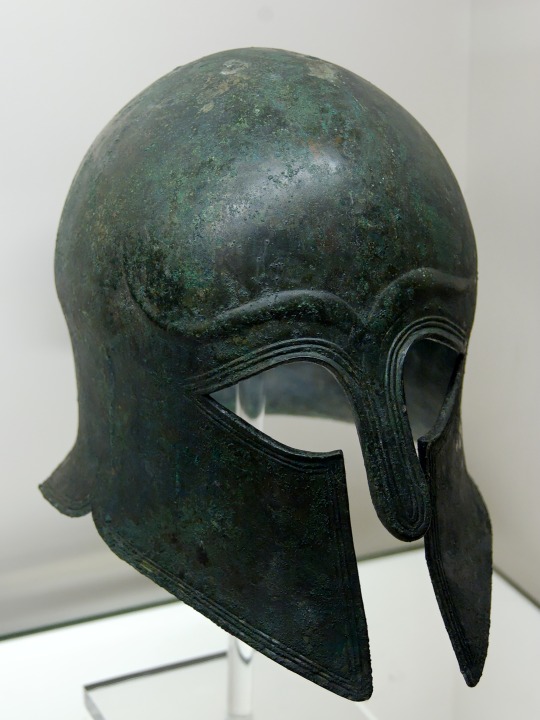#A GREEK BRONZE APULO-CORINTHIAN HELMET
Explore tagged Tumblr posts
Text






A GREEK BRONZE APULO-CORINTHIAN HELMET MAGNA GRAECIA, LATE ARCHAIC TO EARLY CLASSICAL PERIOD, CIRCA 525-475 B.C.
The Apulo-Corinthian helmet type, also called Pseudo-Corinthian, was worn cap-like on top of the head, rather than enclosing the head in the manner of the earlier Corinthian predecessor. The cheek-pieces of this new variant no longer serve their original purpose, as they now angle forward to function as a visor. The form of the nose-guard, eye-openings and gap between the cheek-pieces are now purely decorative. This example features embossed brows above the eye-openings. At the back is a flaring neck-guard, and at the sides, perforations to secure a chin strap. The helmet is surmounted by a tall, forked plume-holder above a twisted stem. The surface is lavishly engraved with addorsed horses above the neck-guard, a boar on the proper-left cheek-guard and a floral motif on either side above the perforations.
#A GREEK BRONZE APULO-CORINTHIAN HELMET#MAGNA GRAECIA#LATE ARCHAIC TO EARLY CLASSICAL PERIOD#CIRCA 525-475 B.C.#bronze#bronze helmet#greek helmet#ancient artifacts#archeology#archeolgst#history#history news#ancient history#ancient culture#ancient civilizations#ancient greece#greek history
32 notes
·
View notes
Text

Apulo-Corinthian type bronze helmet, Greek (Southern Italy), 525-475 BC
from Christies
115 notes
·
View notes
Text

Ancient Greek bronze infantryman's helmet (Apulo-Corinthian style, type A). Manufactured in Apulia, Magna Graecia (present-day Puglia, Italy), ca. 510 BCE; now in the British Museum.
#classics#tagamemnon#Ancient Greece#ancient history#ancient warfare#Archaic Greece#Magna Graecia#art#art history#ancient art#Greek art#Ancient Greek art#Archaic Greek art#South Italian art#Apulia#Apulian art#helmet#bronze#metalwork#bronzework#British Museum
363 notes
·
View notes
Photo


Rare Greek Apulo-Corinthian Helmet, C. 450 BC
A very rare ancient Greek Apulo-Corinthian helmet, damaged and adapted for dedication in ancient times, dating to the 5th century BC.
Helmets of this type originated in modern-day south Italy. They were hammered from a single sheet of bronze and consist of a shallow dome, large neck-flange at the back, very close or fused cheekpieces, closely set “eye holes” and a central nosepiece. Such stylized helmets were made to be worn on the top of the head, as a cap, with a chinstrap holding it in place.
Extraordinarily, the frontal opening of this piece has been entirely obscured in ancient times, with ominously placed bronze bars that seem to anonymize or neutralize the helmet. The modification of ancient helmets and weapons is known from antiquity, at sites such as Olympia, and was usually performed as part of an act of dedication, most often at a temple as a votive gift to the gods. It is probable that this helmet was damaged in battle, perhaps by an impact to the rear, then taken by the victor and modified for dedication to the gods.
#history#greek#apulo-corinthian#helmet#bronze#armor#ancient#5th century bc#antiquities#corinthian#apulian
409 notes
·
View notes
Text

Bronze Helmet of Apulo-Corinthian Type 6th-5th century BC
High, clearly set-off skull with a strongly contoured brow bow. Small eye cut-outs and a short, cut-out nose-guard. Flanged neck-guard with preserved loop. Remnants of a riveted crest-holder on the crown. Profuse engraved decor. An attacking boar is depicted on each cheek-piece. The nape of the neck displays a sphinx, a boar, a lion and a mythical creature. The perimeter and eye cut-outs are bordered in a fine herringbone pattern. This type of helmet was worn atop the head like a cap. The apertures for the eyes and nasal guard were too small to be functional and are purely decorative features. H. 25.5 cm
#Bronze Helmet of Apulo-Corinthian Type#6th-5th century BC#greek helmet#ancient artifacts#archeology#archeolgst#history#history news#ancient history#ancient culture#ancient civilizations#greek history#greek art
50 notes
·
View notes
Photo



Greek Bronze Helmet of Apulo-Corinthian Type, Southern Italy, 4th Century BC
Representing the later style of the characteristic Corinthian form, this is an example of personal armor worn by the Italic Greeks around the 4th century BC. It is skillfully constructed from hammered sheet bronze, the domed form features a broad top flange, with high-arching, M-shaped eyebrows in raised relief. To the back of the helmet, the nape is flared both to allow the soldier to move freely and to protect him from the blows of the enemy but this helmet features a piercing at each end the of neck-guard to secure it by means of a chinstrap. Across the crown are rivets and plates for the attachment of either a horsehair crest, or menacing metal animal horns. It is abundantly decorated with incised chevrons around the eyes and nose-guard, there is a border of zigzags to the rim and two large, confronting boars decorate the joined cheek pieces.
However, unlike its Corinthian cousin, the small eye holes and nose-guard are purely decorative, for this helmet was designed to be worn, cap-like, on top of the head rather than covering the face. Greek art has many depictions of Gods and Heroes wearing their Corinthian tilted up even when battle began, and this practice gave rise to the Apulo helmets. Innovation and comfort aside, this transformed style further allowed the warriors of the Italic Peninsula to still liken themselves to the warriors and Gods depicted in art; celebrating their favored stories that even today, holds strong appeal to our modern taste in sculpture.
#history#greek#helmet#bronze#apulo-corinthian#corinthian#south italy#4th century bc#ancient#armor#antiquities#treasure#boar
479 notes
·
View notes